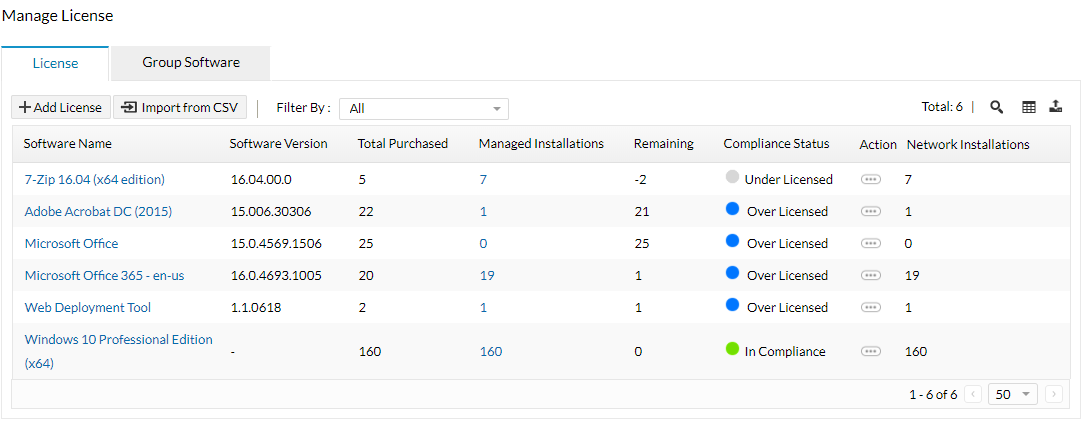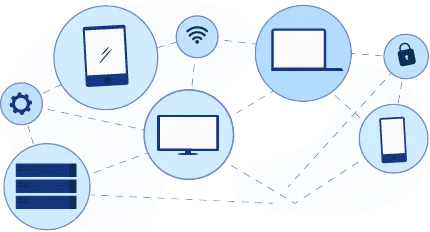License Management Software: Tracking & Compliance
Achieve 442% ROI and $3.7 million in net savings with Endpoint Central.
READ THE STUDY 

Software license management (SLM) is the process of managing software licenses used throughout the organization from a single console. A software license is a legal document produced by the software publishers or distributors that provides rules and guidelines on the usage and distribution of the software. This document usually contains terms and conditions, restrictions, limitations, and disclaimers.
A Software License Management system, part of software asset management, involves software license tracking, documenting, and controlling how and where software is used in your organization. A software license management tool can assist you in complying with license agreements, i.e., end-user license agreements (EULA). A license management software can also be utilized to notify you about the expiry dates, over-usage or under-usage of licenses using a software metering feature.
What is software non-compliance?
Software non-compliance refers to the failure to adhere to the terms of a software license or the unauthorized use of software. This can occur when a person or organization uses software in a way that is not permitted by the license agreement, such as by installing copies of the software on more computers than the license allows or by using the software for commercial purposes without paying for a commercial license. Software non-compliance can also occur when a person or organization modifies or redistributes the software without permission or in violation of the terms of the license.
Software non-compliance can have serious consequences, including legal action by the software manufacturer or publisher and financial penalties. It is important to carefully read and understand the terms of a software license before using the software, and to ensure that the software is used in accordance with the terms of the license.
Key features of Software License Management (SLM) tools
As a part of IT asset management, software License Management (SLM) tool empowers you to carry out all the above mentioned activities in just a few clicks and helps keep software licensing issues in your company at bay.
IT Asset Management software scans the network periodically to detect new software installed/uninstalled within your network. This is done via differential asset scanning and hence allows you to stay up-to-date at all times without utilizing excessive bandwidth within your network.

Software audit tool helps simplify software license compliance management using the following built-in reports:
- Software License Compliance Report: This report gives you details on the commercial software with their software license compliance status. The software license compliance management status is determined based on the input provided in the Manage Software Licenses section on our help page.
- Software Licenses to be Renewed Report: This report provides the list of software whose licenses have to be renewed soon (you can specify the time period). You can also view the software licenses that have already expired by selecting appropriate options.
- Based on the software metering and the usage statistics, you can decide whether or not to renew the licenses.

With the help of a software license audit tool, you can configure email alerts and stay informed on the Inventory dynamics in your organization. Alerts can be generated to notify:
- Non-compliance of software licensing policy (over licensed or under licensed).
- When software is being used post its license validity.
- When the software license usage falls below a specified limit.
Software license management - Best Practices
- Discover installed software - The first step to software licensing management is to identify all the software applications installed in your network. Using a comprehensive software license manager, run an inventory scan on all the endpoints in your network. Software license tracking tool will help you have a clear view of all the commercial and non-commercial software installed.
- Software License Management (SLM) - A license management software is a tool that helps you maintain and store the expiry details, proof of purchase, invoice and other important details associated with the licenses purchased. Although it is a time-consuming process, it will save you in the time of an audit.
- Input and store - It is recommended to update the entirety of the licensed software across a network periodically. An easy way to do this is by uploading the license details in the form of CSV files containing the Product Name, Manufacturer, Version, License Owner, No. of licenses purchased, License Name, Licensed To, Purchased Date, Expired Date, License Key fields separated by comma. Thus, a software license manager can reduce the time and effort involved.
- Schedule reports - Using the software license management tools, configure and schedule reports to manage licensed software usage. This feature will provide a clear view of the number of used and unused licenses. This will assist you in utilizing the purchased licenses in a better fashion. By monitoring the usage metrics using a license management system, the cost spent on unused licenses can be reduced.
- Group software - When you have different versions of a software installed in a network, you can group them together and add the license details for that particular group. Software license management tools makes it easier to manage software licenses purchased and view the versions of that software that are in use in the network.
What is software license management?
Software license management is the process of documenting and monitoring the number of software licenses used in the business so as to be compliant with the End User License Agreement (EULA). And by doing so with a software license compliance tool, the IT team significantly cuts costs on software by purchasing the optimum number of licenses. Most commonly, the IT team uses an IT Asset Management solution that has software license management feature integrated with it.
Types of software licenses:
Broadly, software licenses can be categorized into two types: proprietary (commercial), and free and open source software (non-commercial). The former having the most restrictions with respect to software modification and distribution, thus demanding a software license management tool. Here's the list of different types of software licenses with increasing order of restrictiveness:
- Public Domain Licenses: Anybody can use and modify the software without any restrictions.
- Lesser General Public Licenses (LGPL): The developers can link the open source libraries in the source code and the resulting code can be licensed under any other type of license. However, the LGPL-applicable component should be made available under the same LGPL license.
- Permissive Licenses: Software modification and distribution is possible with a few restrictions in place, and those restrictions differ from one software to another.
- Copyleft Licenses: Developers are allowed to modify and distribute the software provided the same rights remain for further alterations on that software.
- Proprietary Licenses: Nobody is allowed to copy, modify or distribute the software. This is the most restrictive form of licensing, and hence needs a software license management system.
Why do businesses need to be software license compliant?
While purchasing a software, every enterprise agrees to the licensing agreement provided by the software publishers. Software compliance is following those rules and regulations while using the software. Software publishers (such as Adobe, Microsoft) periodically audit their clients' environments to detect, control and prevent piracy, copyright infringement and illegal use of software. To fail one of these audits might mean irreversible damage to a business' reputation, hefty fines, and potential legal action. Hence, to avoid the consequences of failing a compliance audit, enterprises need to ensure license compliance at all times. This can be achieved with the help of license compliance software by employing a software license audit tool.
Steps in software license tracking & management
- Step 1: The first step in software license management is inventory building. Run an asset scan to discover and update your software inventory.
- Step 2: Use the license management software to maintain and store the expiry details, invoice, warranty and other important details associated with the software licenses purchased.
- Step 3: The license management feature also gives you the option to group different editions/versions of a software. This makes the job of tracking multiple licenses easier.
- Step 4: Configure alerts using a license management system to notify you when a particular software is under-licensed or over-licensed.
- Step 5: Utilize the software metering tool in a license management software to track software usage. Using this feature, you can reduce or increase the number of licenses based on usage data.
Benefits of using software license management tools
License management software is a tool that is used to manage and monitor everything related software licenses. Right from expiry dates to warranty details can be uploaded and maintained in a license management software. By using a software license audit tool, software license compliance alerts can be configured to notify you way before software audits. Software metering feature can benefit you by keeping track of the usage metrics of particular software applications which can help you in the next license renewal period. You can avoid unwanted expenditures on unused licenses with the help of software license monitoring tools. You don't have to worry about monitoring several versions of the same software. Utilize the group software feature to add different versions of the same software under the same group for easy software license monitoring.
Software Compliance - What it is & its importance to enterprises
Software compliance is the practice of using the software that has been purchased in accordance to the rules and regulations defined by the software publishers, such as appropriate user licenses. A software license management system helps businesses achieve this from a single console. With software compliance rules getting stricter, it is now crucial to use a software license tracking tool to ensure unlicensed software is not part of your organization. That being said, here are the importances of implementing a software license management software in your organisation:
- Maintaining an up-to-date software inventory: Having complete visibility over the software installed within your network is imperative for achieving software compliance. To monitor and gain visibility on all software installations within the network, you need to run software inventory scans regularly.
- Real-time alerts for non-compliance: Set up real-time alerts using a software license manager for when you're under-licensed, so you can take action right away.
- Prohibit non-business applications: You can block non-business applications within your network to avoid running into surprises.
- Perform internal software license audits: With frequent internal audits using software licensing tools, you can be confident that you are adequately licensed and avoid unexpected fines.
How to achieve software license compliance?
Achieving software license compliance is just one aspect of software licensing management. Managing software licenses also entails optimizing license usage to reduce IT expenditure and consistent software license monitoring. This can be achieved by:
- Monitoring the use of commercial applications to determine whether the licenses are being used efficiently.
- Cutting down costs by uninstalling applications from systems where they're not being used.
- Renewing licenses based on software usage statistics.
- Implementing license compliance software for holistic visbility.
Looking for an MSP offering? Choose Endpoint Central MSP
Manage and secure client endpoints effortlessly. Discover the benefits of choosing us.
Know more


